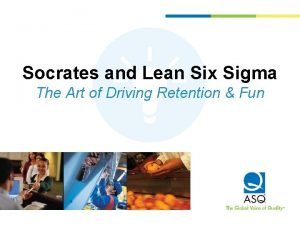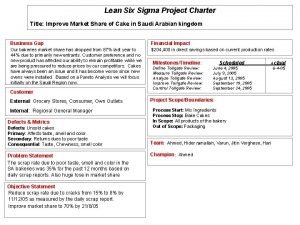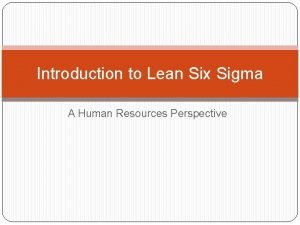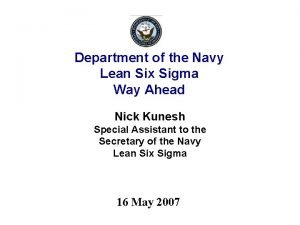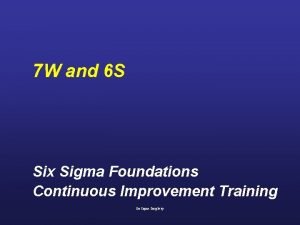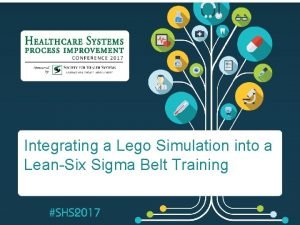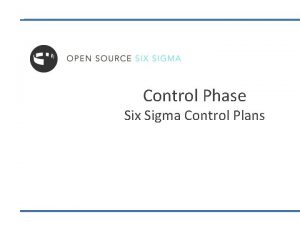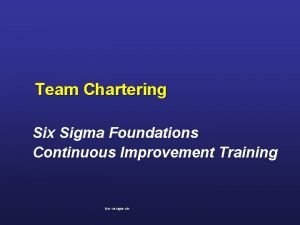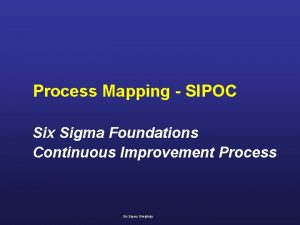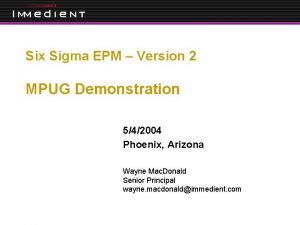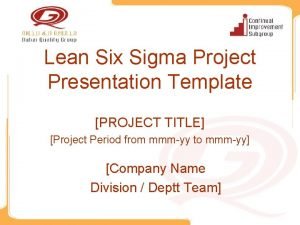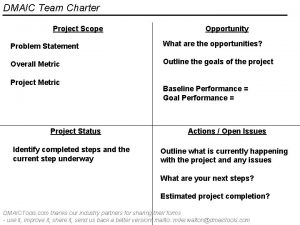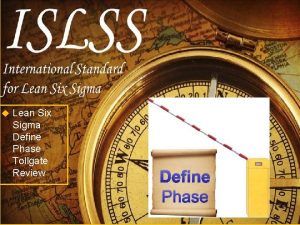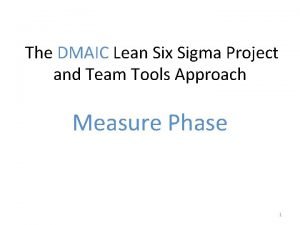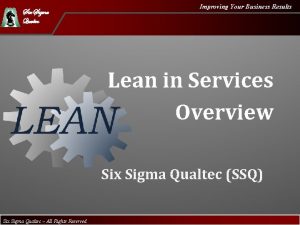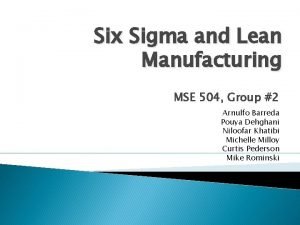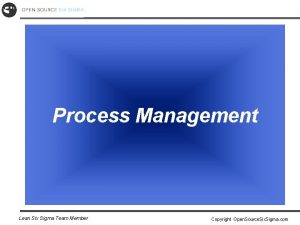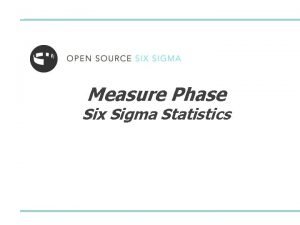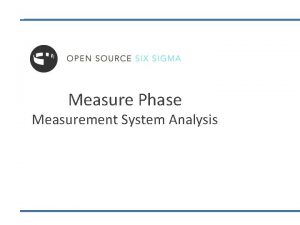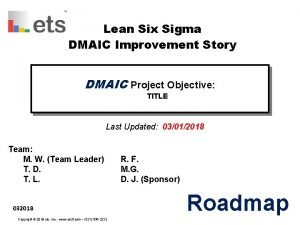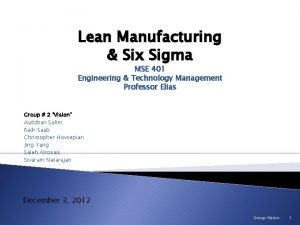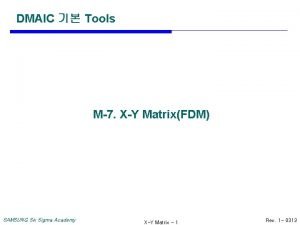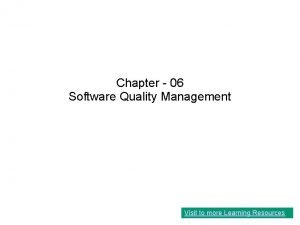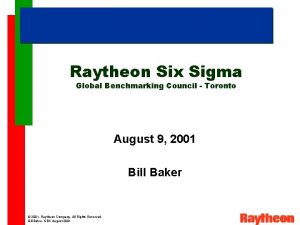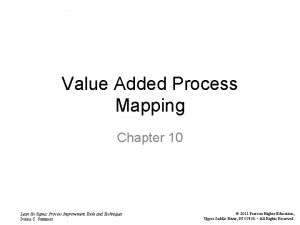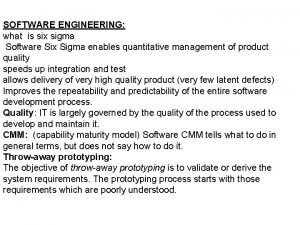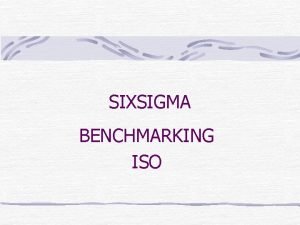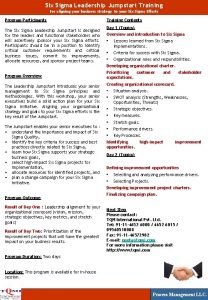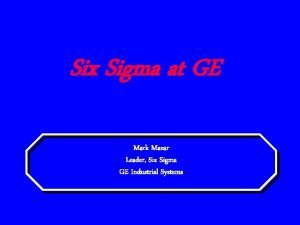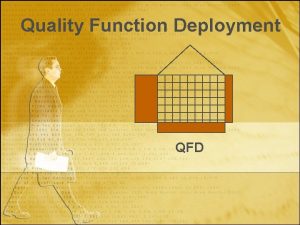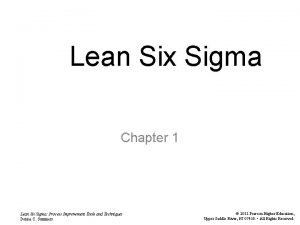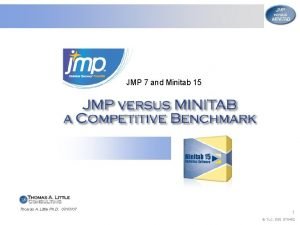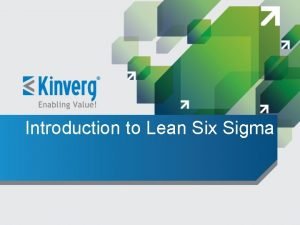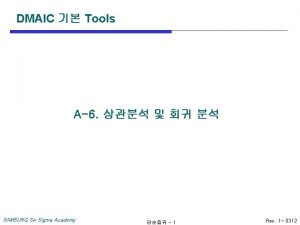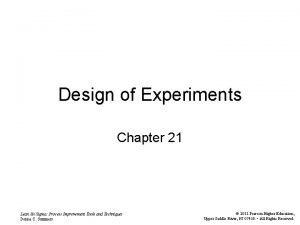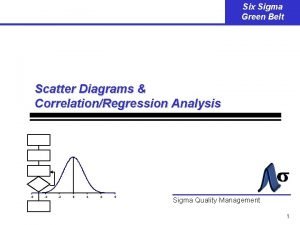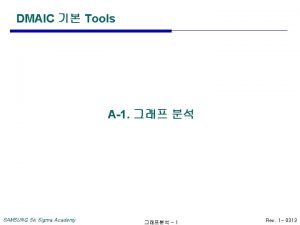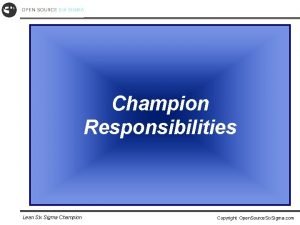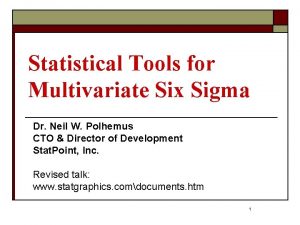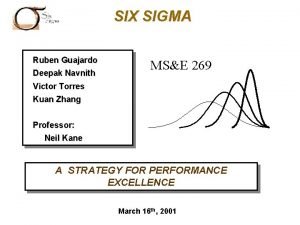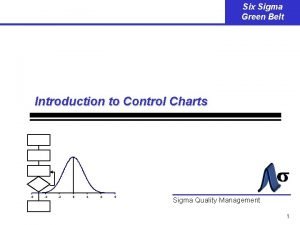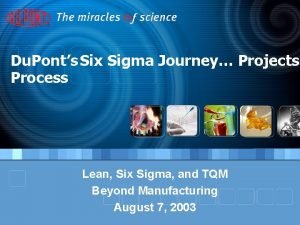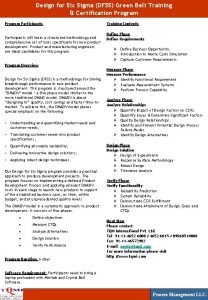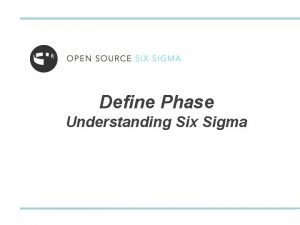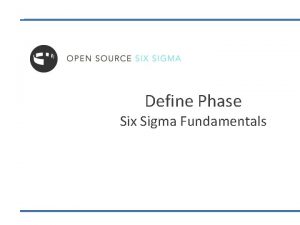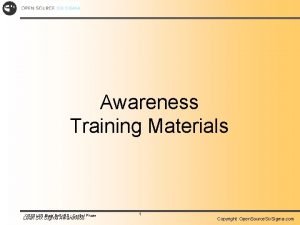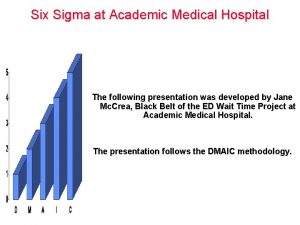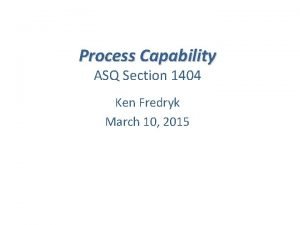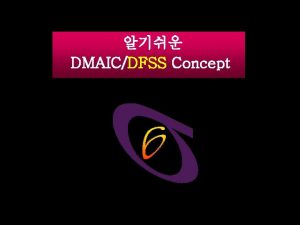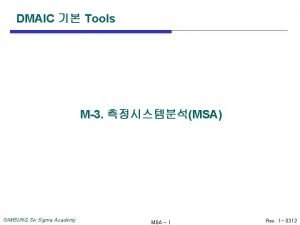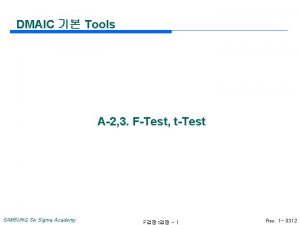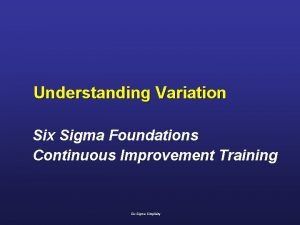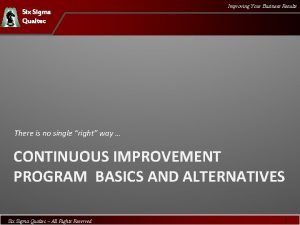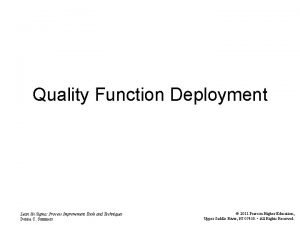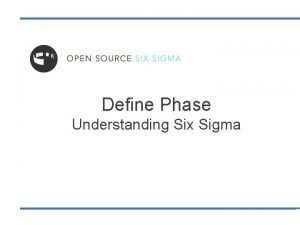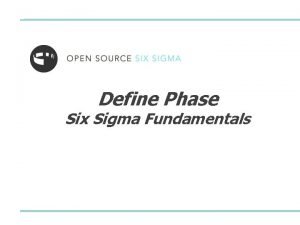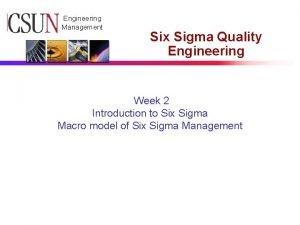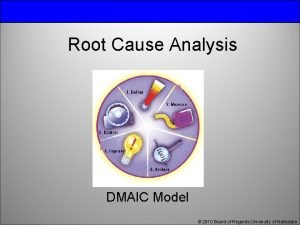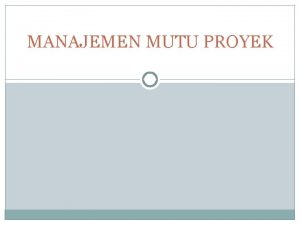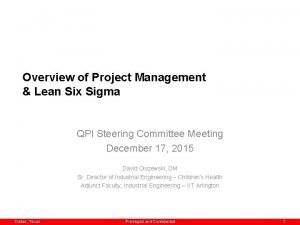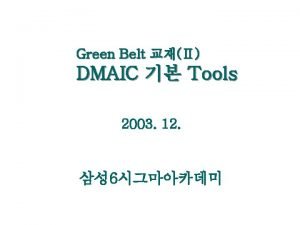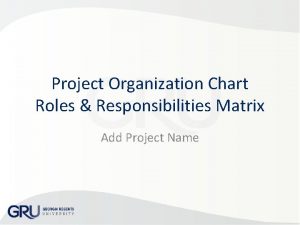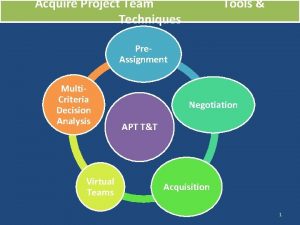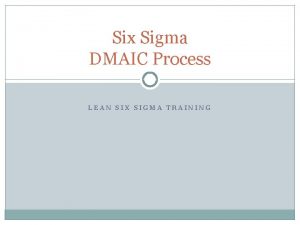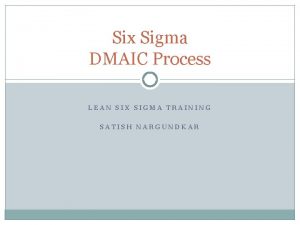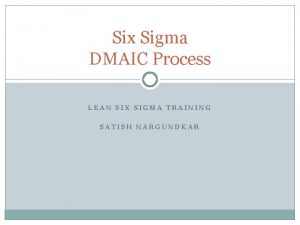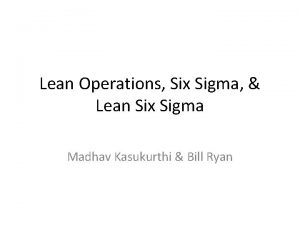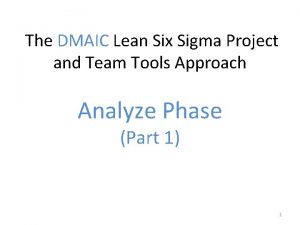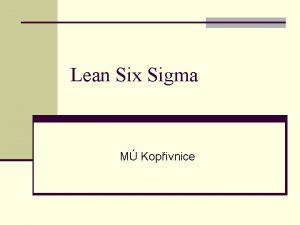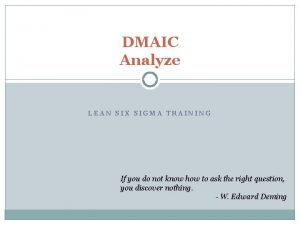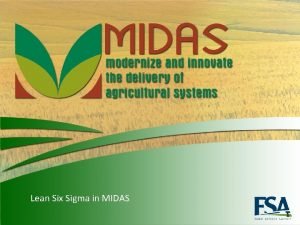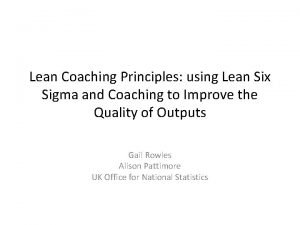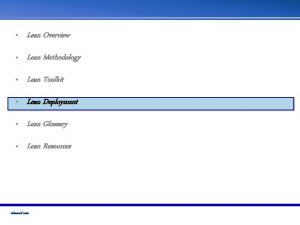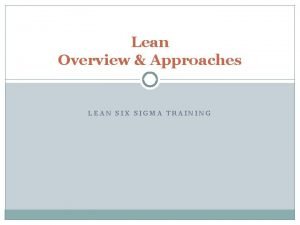The DMAIC Lean Six Sigma Project and Team





































































































































- Slides: 133

The DMAIC Lean Six Sigma Project and Team Tools Approach Improve Phase 1

Six Sigma Improve Phase “The starting point for improvement is to recognize the need. ” - Imai 2 Improve - Introduction

Lean Six Sigma Black Belt Training! Improve Agenda Welcome Back and brief D M A Review Improve Overview Generate and Prioritize Solutions Risk Assessments Evaluate Solutions Approach for Implementation Translate Improvements for Communication Other Improvement Approaches and Support Design for Six Sigma Designed Experiments Applications / Lessons Learned / Conclusions Next Steps 3

Improve Phase Review: Key Steps In alignment with our project goal statement, and given what we have learned in the Define, Measure, and Analyze Phases of our project, during the Improve phase our team will complete: • Generating and prioritizing Solutions (Improvement actions) • Risk assessment • Evaluation of Solutions and Benefits • Approach for Implementation • Translating and communicating learnings to Champion and Process Owner(s) as appropriate We will define and implement GREAT improvement solutions! 4 Improve – Key Deliverables

Lean Six Sigma DMAIC Phase Objectives • Define… what needs to be improved and why • Measure…what is the current state/performance level and potential causes • Analyze…collect data and test to determine significant contributing causes • Improve…identify and implement improvements for the significant causes • Control…hold the gains of the improved process and monitor 5

What is Six Sigma? • A high performance measure of excellence • A metric for quality • A business philosophy to improve customer satisfaction • Focuses on processes and customers • Delivers results that matter for all key stakeholders • A tool for eliminating process variation • Structured methodology to reduce defects • Enables cultural change, it is transformational 6

Six Sigma Is a Set of Powerful Tools Define Problem Definition Project Management 7 Measure Process Mapping Cause & Effect Matrix Analyze Improve Control Key Factors (x) Selection Matrix OCAP Basic Statistics Prioritization chart Standard Work High Level Mapping Fishbone Diagram Regression FMEA Feedback Loops Descriptive Statistics Statistical Analysis Hypothesis Testing Simulation Transition Plans Pareto Value Stream Map ANOVA Benchmarking MSA FMEA SPC Cost/Benefit Analysis Capability Proportions Visual Control Future State Process Map Control Plans

The Lean Six Sigma Approach • Lean Six Sigma is the combination of the Lean and Six Sigma “tool boxes” to create a customer-centric, value-based philosophy and rapid-fire deployment of focused methodologies to transform our business processes to be able to consistently deliver bottom line results that are sustainable and continuously improved. 8 Design for Six Sigma

Six Sigma applied effectively… • Increases customer satisfaction • Lowers costs • Builds better leaders • Empowers an organization to be more data-driven 9

The Basic Philosophy of Lean Six Sigma • • All processes have variation and waste All variation and waste has causes Typically only a few causes are significant To the degree that those causes can be understood they can be controlled • Designs must be robust to the effects of the remaining process variation • This is true for products, processes, information transfer, transactions, everything • Uncontrolled variation and waste is the enemy 10

The basic focus of Six Sigma Therefore, to understand the output (results) we are getting, we must study and understand the process and inputs that go into producing the output we are getting. Y = f(Xs) …data-driven problem solving and continuous improvement 11

Six Sigma DMAIC Projects Analyze Phase – What does the process data reveal? – What are the Critical Key Xs? – How much variation in “Y” from the Key “Xs”? – What “Xs” can be and need to be improved (Root Causes)? 12

Y=f(x) Process Mapping Pareto C&E Matrix, Fishbone FMEA SIPOC Capability Study Measurement Systems Analysis Pareto Chart, Correlation/Regression Hypothesis Tests, ANOVA, Descriptive Statistics, t-tests, Proportions Prioritization Matrix, Improvement Ideas, C&E Matrix, Future State Map, PDSA Control Plans, SOPs, SPC, Mistake Proofing Only the Critical Xs need to be monitored and controlled long term 13 Measure Phase 15 -70 xs Analyze Phase 7 -15 xs Improve Phase 3 -7 xs Control Phase 3 or fewer xs

Six Sigma Improve Phase (pg. 14 -16) The Improve Phase is a systematic approach for examining the identified key xs, and determining, testing, and implementing the best solution(s). 1. What changes can we make that will result in a sustainable improvement in the process output? 2. How will we know that a change has resulted in an improvement in the process output? 14 Improve – Introduction

Six Sigma Improve Phase (pg. 14 -16) • Through process analysis, you will generate and test robust solutions shown to affect the proven causes (xs) that affect the critical output (Y) in a positive manner. • The result will be an improved process that is stable, predictable, and one that consistently meets customer requirements. 15 Improve – Introduction

The (Rational) Improvement Alternative to Downward Spiralling Budget Lids/Hiring Freezes Improve to Six Sigma performance levels Across-the-board cuts Eliminate chronic problems Programs eliminated Eliminate non-valueadded work Consolidation of units Downsizing/ Restructuring 16 Improve – Introduction Eliminate waste / rework

Improve Phase: Technology and Training - Right? New and Improved Technology and Training could be the most robust solution, but always remember to: “Reach for the mind before you reach for the wallet” - borrowed 17 Improve – Introduction

The Default Solutions… • • • Training & education New technology Working harder or faster More inspection or auditing New policies More people working in a broken process …Are not always the right solutions! 18 Improve – Introduction

Why People Don’t Do What They Are Expected To Do (Robert Mager) • They don’t know how to do it. • They don’t know what’s expected of them. • They don’t have the authority to do it. • They don’t get timely information about how well they are doing. (In other words, they don’t get feedback. ) • Their information sources (documentation) are poorly designed, inaccessible, or nonexistent. 19 Improve – Introduction

Why People Don’t Do What They Are Expected To Do (Cont’d) • They don’t have job aids to cue correct performance. • Their work stations provide obstacles to desired performance. • The organizational structure makes performing difficult. • They are punished or ignored for doing things right. 20 Improve – Introduction

Why People Don’t Do What They Are Expected To Do (Cont’d) • They’re rewarded for doing things wrong. • Nobody ever notices whether they perform correctly or not. Have we addressed each of these previous 11 concerns as to why people don’t do what they are supposed to do through our Improvement and Control actions? 21 Improve – Introduction

Data-Driven Problem Solving To be successful with any Six Sigma project, you have to affect at least one of the following: –Reduce Variation –Shift the Mean –Eliminate Outliers 22

Characteristic of the Performance Gap… (Problem) Accuracy and/or Precision Off-Target Variation LSL USL On-Target Center Process Reduce Spread LSL USL LSL = Lower spec limit USL = Upper spec limit The statistical approach to problem solving 23

24 Long-Term Yield vs Process Sigma 4σ 100% 3σ 6, 210 DPMO 66, 807 DPMO Long-term Yield 90% 80% 5σ 233 DPMO 6σ 3. 4 DPMO 2σ 70% 308, 537 DPMO 60% 50% 40% 1σ 30% 690, 000 DPMO 20% 10% 0% 0 1 2 3 Process Sigma 4 5 6

Six Sigma Improve Improving the identified Key Xs to Improve the Process (Y) and the Customer’s Experience 25

Key Deliverables for Improve • Main elements of Define, Measure, and Analyze completed • “Obvious Xs” identified and confirmed • Potential Xs identified, data collected and confirmed (Root Causes) • Improvement solutions generated and prioritized upon investigation of root causes and supported with data 26 Improve – Review & Key Deliverables

Key Deliverables for Improve • Improvement solutions tested (pilot) and benefits estimated • Implementation plan for solution(s) drafted with input from process owners • Champion approval of the key solution(s) implementation 27 Improve – Review & Key Deliverables

Six Sigma Improve Phase “I know of no more encouraging fact than the unquestionable ability of mankind to elevate his life through a conscience endeavor. ” - Henry David Thoreau 28

Improve Phase Review: Key Steps In alignment with our project goal statement, and given what we have learned in the Define, Measure, and Analyze Phases of our project, during the Improve phase our team will complete: • Generating and prioritizing Solutions (Improvement actions) • Risk assessment • Evaluation of Solutions and Benefits • Approach for Implementation • Translating and communicating learnings to Champion and Process Owner(s) as appropriate 29 Improve – Review & Key Deliverables

Improve Phase: Generate Solutions • The objective is to generate ideas - come up with ways to impact our key xs in a way that will lead to an improved, consistent output. Be creative, find “out-of-the-box” solutions, invent potential fixes, and find ways to optimize your process. • There are many ways of generating ideas. Here are four of the most common and useful: – Brainstorming – Affinity Diagrams (using key xs) – Process Mapping (current v. future) – Best practices/benchmarking 30 Improve – Generate Solutions

Improve Phase: Generate Solutions – Brainstorming (pg 27 -29) • A question or statement about an identified key x that negatively impacts Y is written on a board or flip chart for the entire team to see. • Creative thinking is used as team members suggest potential improvements for the stated x. All ideas are recorded without any judgment initially of their validity. “Out of the box” thinking is strongly encouraged here, and “spring-boarding” off of others ideas is powerful. • Think beyond the “status quo” or self imposed rules from the culture of the organization. 31 Improve – Generate Solutions

Improve Phase: Generate Solutions Brainstorming Questions to Consider • Where is the process step done? Can it be done elsewhere? • Who performs the step? Can someone else perform the step? • When is the step performed? Can the timing be changed? • Under what conditions is the step performed? Can the conditions be changed? • What resources are required for the process step? Where else can resources be found? What else can be used? • How is the process step controlled? Is it value - adding? • What does the customer really need? How is the customer using the process output - product or service? 32 Improve – Generate Solutions

Brainstorming Guidelines • Clarify the question being considered • Go around to each member asking for input, but also allow ideas to be written down - as on a sticky note, etc. • Do not make any critical comments about initial ideas submitted by team members - only ask for clarification if needed • Strive for a high quantity of ideas to begin with, then move toward “quality” 33 Improve – Generate Solutions

Improve Phase: Generate Solutions - Affinity Diagrams (pg 30 -31) • An Affinity Diagram is used to help a team discover meaningful groups of ideas or relationships within a raw list of ideas - as coming potentially from a brainstorming session. • Affinity diagrams are helpful when: – – 34 facts or thoughts are uncertain and need to be organized preexisting ideas or paradigms need to be overcome ideas need to be clarified unity within a team needs to be strengthened Improve – Generate Solutions

Improve Phase: Generate Solutions - Affinity Diagrams • To create an affinity diagram, the team sorts a brainstormed list, moving ideas from the raw list into affinity sets, creating groups of related ideas. This can easily be done by writing on a flipchart, or using post-it notes to “re-stick” into affinity groups. • Basic guidelines for affinity diagrams: – – – 35 Rapidly group ideas together that seem to belong together Clarify any ideas in question Initially, it isn’t important to define why they belong together Copy an idea into more than one affinity set if appropriate Seek to summarize or name each set with appropriate titles and this may lead to more robust improvement ideas / actions Improve – Generate Solutions

Improve Phase: Process Mapping (pg. 34 -41) • A process is a sequence of steps or activities using inputs to produce an output (accomplish a given task). • A process map is a visual tool that documents a process. • Several styles and varying levels of detail are used in Process Mapping. Most common and useful styles are SIPOC, Flow Diagrams, Box Step, and Value Stream Maps. 36 Improve – Generate Solutions

Improve Phase: Process Mapping • The team should start with the observed, current, asis process. • Start high-level, and work to the level of detail necessary for your project (key inputs). • As inconsistencies are discovered, the team can develop a future state or should-be process map to improve the key xs and the overall output (Y) of the process. 37 Improve – Generate Solutions

Analyze Roadmap: Process Analysis Types of Process Delays or Errors: • • 38 Gaps Redundancies Implicit or unclear requirements Bottlenecks Hand-offs Conflicting objectives Common problem areas

Improve Phase: Process Mapping for Process Improvement True “process improvements” usually DON’T come from: - working harder using a broken or inefficient process - education or re-education - blaming / threatening / coercion / policies Consider: - making changes that “make it easy to do it right” - hardwire in desired defaults - eliminate process steps that don’t add value - if you have too much variation or “special cause”, designing a consistent process should be your first step to improvement Langley, et. al. “The Improvement Guide - A practical Approach to Enhancing Organizational Performance”. 39 Improve – Generate Solutions

Improve Phase: Generate Solutions - Best Practices / Benchmarking (pg. 254 -255) Benchmarking is measuring your process performance against other “best in class” similar processes internally and / or externally as appropriate. Adopt the process steps and parameters as appropriate to obtain the desired output results from your own process. “Best practices are a sustainable competitive advantage. It’s true that, once a best practice is out there, everybody can imitate it, but organizations that win do two things: they imitate and improve it. ” - Jack Welch 40 Improve – Generate Solutions

Types of Benchmarks (pg 255) Pros Cons Internal/ Company Establishes a baseline for external benchmarking Identifies differences within the company Provides rapid and easy-to-adapt improvements Opportunities for improvement are limited to the company’s internal best practices Direct Competition Prioritizes areas of improvement according to competition Initial area of interest to most companies Best used for in-depth studies as supplement to competitive intelligence studies Often a limited pool of participants Opportunities for improvement are limited to “known” competitive practices Potential antitrust issues Industry Provides industry trend information Provides management with a conventional basis for quantitative and process-based comparison Opportunities for improvement may be limited by industry paradigms Best-In. Class Examines multiple industries Provides the best opportunity for identifying radically innovative practices and processes Provides a brand new perspective Free exchange of information more likely to occur Often difficult to identify best-in-class companies Sometimes difficult to get best-inclass companies to participate 41

Improve Phase: Prioritize Solutions • Once you have a set of potential solutions, your team will need to narrow down your list by identifying the best solutions to test. • You will need to consider a number of factors: impact, cost, resources, etc. – Multivoting – Prioritization matrix 42 Improve – Prioritize Solutions

Improve Phase: Prioritize Solutions – Multivoting (pg 31 -32) • Multivoting narrows a large list of possibilities to a smaller list of the top priorities or to a final selection. • Multivoting is preferable to straight up or down voting because it allows an item that is favored by all, but not the top choice of any, to rise to the top. • Usually follows brainstorming or affinity diagramming to prioritize the main ideas. 43 Improve – Prioritize Solutions

Improve Phase: Prioritize Solutions - Multivoting • To conduct the multivoting process, the team works from a brainstormed list of ideas, options, etc. This can easily be done by writing on a flipchart, marker board, or using post-it notes. Each team member will have a marker, or self-adhesive dots to use for voting. The number of multiple votes each member gets depends on the size of the list, but it is usually about one third of the total number of items on the list. • Basic guidelines for multivoting: – All team members get an equal number of votes – A member can distribute their votes or cast all of them for one idea – If two or three ideas are close in voting, then a multivote can occur with those two or three ideas listed 44 Improve – Prioritize Solutions

Multivoting Example Budget Priorities New billing system Additional staff Hire Six Sigma consultant Improve office equipment Increase travel budget 45

Improve Phase: Prioritize Solutions - Prioritization Matrix • A prioritization matrix is used to compare choices (options, improve approaches, etc. ) relative to criteria such as cost, ease of implementation, resources, effort, etc. • This tool forces a team to focus on the best things to do, not everything they could do, dramatically increasing the chances for implementation success. 46 Improve – Prioritize Solutions

Improve Phase: Prioritize Solutions - Prioritization Matrix Basic guidelines for a prioritization matrix: – Virtually any criteria or factor can be used for ranking the options – Effort (resources, costs) vs. Impact is a common matrix format for ranking potential improvement activities – A cause and effect matrix is a form of a prioritization matrix – All team members should come to consensus on the ranking of each option 47 Improve – Prioritize Solutions

Complexity / Amount of Work Required Sample Prioritization Matrix: Lean Pharmacy 48 Impact for Pharmacy Low Impact Medium Impact Low Complexity -Omnicell restock process -Workstation design: Repackaging area -Kanban inventory; Frozen stock Medium Complexity -Crashcart design/quantity; standard work for restock -Workstation/room layout; IV room -Workstation design; Order entry area High Complexity -Delivery cart setup and delivery process -Order clarification process -Workstation design: Med pick area -Standard work system; job guidance sheets: all areas Improve – Prioritize Solutions High Impact -Kanban inventory: IV fluid boxes -Metrics development and tracking

Generate and Prioritize Solutions. Summary – Brainstorming – Affinity Diagrams (using key xs) – Process Mapping (current v. future) – Best practices/benchmarking – Prioritization 49

Improve Phase: Risk Assessment • Even your solutions may have potential flaws or gaps at which they could break down. • You will need multiple participants with different perspectives in this process to identify the potential problems and possible modifications to create the most robust improvement solution with minimized risk. • The two techniques for assessing risk that we will focus on are: – Force Field Analysis (FFA) – Failure Mode and Effect Analysis (FMEA) 50 Improve – Assess Risks

Improve Phase Assess Risks - Force Field Analysis (FFA) • FFA is a method borrowed from a Mechanical Engineering technique known as Free-Body Diagramming, and from social psychology studies in human behavior. • FFA is used to identify all the forces surrounding and acting on a body (plan, improvement implementation, etc. ) • The objective is to ascertain the forces leading to an equilibrium state (determine the resources and costs) • Generates a chart or table for further analysis or presentation • With FFA, “EQUILIBRIUM” can be: – a desired goal – the status-quo 51 Improve – Assess Risks

FFA - Barriers & Enablers Driving Forces 52 Restraining Forces E B N A A R B R L I E E R R S S Improve – Assess Risks

FFA - Barriers & Enablers 53 Improve – Assess Risks

Improve Phase Assess Risks - FMEA Failure Mode and Effects Analysis 54 Improve – Assess Risks - FMEA

FMEA (Failure Mode and Effects Analysis) (pg 270 -273) • A documented methodology for evaluating, prioritizing, and analyzing risks with the objective of eliminating or minimizing these risks through a team effort. • A systematized group of structured activities to: 1. recognize and evaluate the potential failure of a product or process and its effect, 2. identify actions which could eliminate or reduce the chance of the potential failure occurring, and 3. document the process. • An FMEA is very complementary to defining what a product / process must do to consistently meet the needs of the customer. 55 Improve – Assess Risks - FMEA

Using FMEA in DMAIC • During MEASURE to: – Assess the current process failures and risk – Identify potential Xs to be tested • During IMPROVE to: – To evaluate potential risk for improvement ideas – Prioritize improvements with high risk – To generate additional improvement ideas 56 Improve – Assess Risks - FMEA

FMEAs Basically Answer: • What process step or product function could fail? • What would be the effect of that failure occurring and how severe would that effect be (severity)? • What are the potential root causes of the failure and what is the likelihood or frequency of those root causes causing the failure (occurrence)? • What current controls are in place to stop or immediately detect the potential root causes and how effective are those controls (detection)? • What recommended actions should be taken to minimize or reduce the likelihood of the greatest risks identified? 57 Improve – Assess Risks - FMEA

FMEAs Risk Prioritization • A ranking system, usually on a scale of 1 to 10, is used by the team for each of these categories: Severity Occurrence Detection • A Risk Priority Number (RPN) is calculated for each single potential cause and associated failure mode by multiplying the three ranked values. These relative ranked values are used to identify the greatest risks and prioritize actions. 58 Improve – Assess Risks - FMEA

How Bad? What is the Input What can go wrong with the Input? What is the Effect on the Outputs? How Often? What are the Causes? How well? How are these found or prevented ? What can be done? Steps Improve – Assess Risks - FMEA 59

FMEA - Step by Step (pg. 270) 1. For each Process Input, determine ways the Input can go wrong (Failure Modes) 2. For each Failure Mode associated with Inputs, determine Effects of Failures on customers 3. Identify potential Cause(s) of each Failure Mode 4. List Current Controls for each Cause or Failure Mode 5. Use standard, or create, Severity, Occurrence, and Detection rating scales 6. Assign Severity, Occurrence, and Detection ratings to each Cause 7. Calculate RPNs for each Cause 8. Determine Recommended Actions to reduce high RPNs 9. Complete Recommended Actions and recalculate RPNs 60 Improve – Assess Risks - FMEA

Example FMEA 61 Improve – Assess Risks - FMEA

FMEA Hints • Keep it simple; not complex • Must involve a team, usually 3 to 6 members, no “lone ranger” development • Update it as you move through the process and knowledge increases • Make sure the FMEA is an action tool, not just a document; use the right half of the tool 62 Improve – Assess Risks - FMEA

Improve Phase: Evaluation of Solutions (Pilot) (pg 273 -276) • You will want to run trials of your selected improvement solutions in a real environment. • A test of all or part of a proposed solution on a small scale in order to better understand its effects and to learn how to make the full-scale implementation more effective. • It is sometimes called a pilot test, a trial, or a small test of change 63 Improve – Test Solutions

PDSA: Plan Do Study Act • The Deming cycle, or PDSA cycle, is an improvement model consisting of a logical sequence of four repetitive steps for continuous improvement and learning. It may also be called the Deming wheel of continuous improvement. • Its origin can be traced back to the 1920’s when Walter Shewart, statistics expert at Bell Laboratories, introduced the improvement concept of Plan, Do, and then See. 64 Improve – PDSA

Basic PDSA Steps PLAN 1. Identify the problem and desired outcome 2. Identify the most likely causes/factors using data 3. Identify potential solutions and the data needed for evaluation (plan the details of the change: the who, what, when, and where) Act Plan Study Do DO 4. Implement solutions and collect data needed for evaluation. Make sure the data collected allows you to assess progress toward the desired outcome or target. STUDY 5. Analyze data and develop conclusions ACT 6. 65 Recommend further study and/or action

Improvement Implementation Plan “Truth is found more often from mistakes than from confusion. ” - Francis Bacon, 1561 - 1626 Changes that result in improvement A P S D 66 Series of small tests Learn as you go Data driven test cycles Prioritized Solutions and Ideas

Appropriate Scope for a Pilot Test Readiness for Change Current Situation Low Confidence that change idea will lead to Improvement High Confidence that change idea will lead to Improvement Resistant Indifferent Ready Cost of failure large Very Small Scale Test Cost of failure small Very Small Scale Test Cost of failure large Very Small Scale Test Large Scale Test Cost of failure small Scale Test Large Scale Test Implement Provost, Lloyd. CHAI Fall Conference. Nashville, TN. Sep 2004 67 Improve – Test Solutions

Improve Phase: Benefits Estimation How much positive change in “Y” will occur as a result of this improvement, and how much is this positive change worth to our organization? ― Unit cost ― Total Resource ― Benchmark (Gold standard) ― Process Flow 68 Improve – Benefits Estimation

Improve Phase: Benefits Estimation • Unit cost – Cost of each defect x number of occurrences • Total Resource – Total resources used to do an activity – % of time on non-value add activity = total opportunity • Benchmark (Gold standard) – Compare our performance to a gold standard; what is the quantifiable gap • Process Flow – From our process map, what are the NVA steps/activities – Design new process to eliminate NVA steps 69 Improve – Benefits Estimation

Improve Phase: Approach for Implementation of Improvements • Clearly identify who the process owner is and all associates involved in the process • Identify all documentation related to the process being improved and determine what modifications / updates need to be made (Policies, Procedures, Work Instructions, etc. ) • Develop a communication plan – Who will be impacted by the change? – Communicate before the change goes into effect • Create a simple responsibility matrix to identify who will be doing what when, and ensure Champion is in agreement • Monitor and Adjust if needed as the improvement is incorporated into the process 70 Improve – Implementation Approach and Plan

Improve Phase: Translating and Communicating Learnings for Champion Approval • For all significant improvement changes, the project’s Executive Champion must be informed and must formally approve the implementation. • Before discussing improvement implementation with your champion, you must have “done your homework” and have data to support your plan including risk assessment, pilot testing results, resources needed, and potential benefits. 71 Improve – Champion Approval

Lean Six Sigma Improvement Approaches and Support Tools 72

Resource Guide to Change Concepts The Improvement Guide (pg. 293 -299) • Consider potential consequences of applying change concepts • The concepts are guidelines and general in nature • Every change concept does not apply to every problem • What change can we make that will result in improvement? • “While all changes do not lead to improvement, all improvement requires change. ” 73 Improve – Change Concepts

Value Added vs. Non-Value Added • Value Adding Process – A process step that transforms or shapes a product or service towards that which is sold to a customer. Changes “form, fit, or function” in a way that customers are willing to pay for • Non-Value Adding Process – Those process steps that take time, resources, or space, but do not add to the value of the product or service itself (These activities should be eliminated, simplified, reduced or integrated) 74 Improve – Eliminate Waste

Eight Wastes Wrong info Info missing Keypunch error Medical Error zzz zz Motion: Walking or Reaching Inventory Sign-offs Waiting Rework / Quality Defects 12 1 9 6 4 10 8 No way! 13 2 3 11 Inspection Over-Production & Over- Processing 5 7 Transportation Waste of People: Underutilized or 75 Unused Creativity

Why Lean Tools? • Six Sigma and Lean are very complimentary approaches to improvement • Often creates rapid improvement and elimination of the eight wastes • Creates a stable process which can be further improved • When deployed correctly, embeds a rapid continuous improvement mindset in the culture • Drives shorter lead-times, reduced inventory, lowers costs 76 Improve – Eliminate Waste

Does a distance of 45 feet Matter? Example: Le. Bonheur Lab Renovation Initial Design Tube System Location 45 feet each way = 90 feet walked per specimen 250, 000 core lab specimens per year = 22, 500, 000 feet per year walked = 4, 260 miles per year walked (the distance from New York to Rome) At two miles per hour, = 2130 hours per year = 1. 02 FTEs per year moving the sample from tube station to receiving area 77 Improve – Improve Work Flow

Move Steps in the Process Closer Together & Synchronize Blue = Processor After Red = Zone 1 Operator 78

Do Tasks in Parallel / Eliminate Batching Smaller centrifuge allows for individual single piece testing, instead of waiting for a large centrifuge to fill with specimens before spinning (batch) 79 Improve – Improve Work Flow

Take Care of Basics: 5 S 1) Sort Clear out rarely used items by red tagging 5) Sustain Use regular management audits to stay disciplined 80 2) Straighten Organize and label a place for everything 4) Standardize 3) Shine Create rules to sustain the first 3 S’s Clean it Improve – Change Work Environment

Did somebody order some 5 S? 81

Post 5 S Improvement Results 82 Improve – Change Work Environment

Sustain 83

Standard Work 84

Ten Types of Human Errors (and how to protect against them) 1. Forgetfulness - Protection: alerting operators in advance, regular checking, automated reminders 2. Misunderstanding - Protection: std work, training, checking in advance 3. Identification – Protection: training, attentiveness, vigilance 4. Lack of experience – Protection: Skill building, work standardization 5. Ignoring rules – Protection: Basic education, experience, audits, discipline 6. Inadvertent – Protection: Attentiveness, discipline, std work 7. Slowness, delays in judgment – Protection: Skill building, std work 8. No standards – Protection: work instructions, std work 9. Surprise – Protection: Preventative maintenance, std work 10. Intentional – Protection: Education, discipline 85

Defect Sources • • • Omitted processing Processing errors Setting up work pieces Missing parts Wrong parts Processing wrong work piece Misoperation Adjustment error Improper setup Tools, fixtures, jigs improperly prepared Improve – Design Systems to Avoid Mistakes 86

Design for Six Sigma DFSS 87

Improvement from the Start • DFSS (Design for Six Sigma) builds a process that is designed to operate at a Six Sigma level of performance from the very launch of the new process. It focuses on the customer (needs), reviews current related processes, and benchmarks internally and externally 88 Design for Six Sigma

Design for Six Sigma • DMAIC is structured to improve an existing process - reduce variation, eliminate defects. • Design for Six Sigma (DFSS) uses DMADV (Define Measure, Analyze, Design, Validate); or IDOV (Identify, Design, Optimize, Verify) to create a new process that produces minimal defects from the start • We usually focus on DMAIC 89 Design for Six Sigma

Design for Six Sigma • The intent of DFSS is to bring a new product or service to “market” with a process performance near a six sigma level for each key customer requirement of the product / service. • DFSS is essentially an attitude and approach toward new or re-designed products and services, and not a methodology. The DFSS concept utilizes methodologies such as DMADV or IDOV. 90 Design for Six Sigma

Design for Six Sigma • DMADV and IDOV are very similar and basically provide a structured roadmap to create a new product or design a new process that has minimal variation and defects • The key initial focus areas of DFSS include collecting, analyzing, and clearly understanding the VOC and CTQs - “What would a Six Sigma level performing product or process need to look like, or consistently produce? ” 91 Design for Six Sigma

Design for Six Sigma - IDOV • Identify - Quantified customer information along with technical requirements, specifications, and performance targets are identified and documented. • Design - The CTQs are emphasized, and all key inputs considered as conceptual designs are evaluated to create a new process that produces minimal defects 92 Design for Six Sigma

Design for Six Sigma - IDOV • Optimize - The capability of the new process to meet all critical requirements is evaluated, and the design is optimized through simulation, small scale tests, benchmarked data, etc. • Verify - The optimized process design is formally tested and validated to consistently meet critical requirements. Longer term monitoring and feedback may be necessary. 93 Design for Six Sigma

Design for Six Sigma - DMADV • Define - Define the project goals and customer deliverables • Measure - Determine customer needs and specifications • Analyze - Study process options to meet the customer’s needs • Design - Develop process details to meet the critical requirements • Validate - Verify the design performance and ability to consistently meet customer’s needs 94 Design for Six Sigma

Design for Six Sigma Common Tools • SIPOC (VOC and CTQ emphasized) • Detailed Process Maps • QFD - Quality Function Deployment • FMEA • Simulation and Small Scale Testing • Poka-Yoke (Mistake Proofing) 95 Design for Six Sigma

IDOV and DMADV 96

Designed Experiments or Design of Experiments (DOE) 97

Design of Experiment • DOE identifies how factors (Xs) alone and in combination affect a process and its outputs (Ys). • DOE is a systematic approach • Provides a mathematical model • Identifies the best combinations of Xs 98

Why is DOE needed? • A man decided to investigate the causes of intoxication. • On his first trial, he drank whiskey and water and became intoxicated. • On his second trial, he held all variables constant except one… he replaced the whiskey with vodka… and became intoxicated • On the third trial, he used bourbon instead of whiskey and vodka… and became intoxicated. • After recovering, he concluded that water causes intoxication, because it was the only constant variable! 99

Designed Experiments or Design of Experiments (DOE) pg 184 - 194 • DOE is a structured approach to improve an existing process by testing multiple factors at a time thus reducing the number of experimental runs and time needed for testing • The most important factors affecting a given output of a process, and the controlled tested factor’s best settings are identified. 100 Six Sigma DOE

Alternatives • One Factor at a Time (OFAT) – A given factor tested at multiple levels while holding everything else constant. This approach may work OK in a high school chemistry lab, but it can be very time consuming and inefficient when applied to a complex process in a “working” environment. • Many Things at Once – it becomes difficult to determine which changes contributed to the effects and to what degree, might keep doing something that is harmful to results, impossible to assess cost/benefit for each change 101 Six Sigma DOE

Alternatives • Not every project has to include a designed experiment. Many will use pilots of controlled small tests of change or work-out sessions to achieve improvements… but considering DOE as appropriate doesn’t hurt, either! 102 Six Sigma DOE

Designed Experiments or Design of Experiments (DOE) • Results from DOEs identify main effects from the tested controlled factors as to the extent the factors influence chosen response variables. • The factors would be considered the inputs, and the response variables would be the outputs. • Results from DOEs also look at how the interactions of the factors influence the response variables. 103 Six Sigma DOE

One Factor at a Time Which gas type and engine timing setting will produce the best gas mileage? Gas Type Timing Set up MPG G 1 T 1 30 G 2 T 1 20 Since G 1 produced the best mileage, test it against both timing settings… Gas Type Timing Set up MPG G 1 T 1 30 G 1 T 2 25 Best Value! But… what did we miss? 104

DOE shows the effects of interactions Gas Type Timing Set up MPG G 1 T 1 30 G 1 T 2 25 G 2 T 1 20 G 2 T 2 45 This interaction was missed using one factor at a time! 50 40 30 G 1 20 G 2 T 1 T 2 105

Terminology • Factors – the variables you are testing • Levels – the settings you are checking for each factor • Factorial – describes the basic design – 2 x 3 design describes 3 factors– one at 2 levels and two at 3 levels… 18 trials or “runs” in all – 2 k describes an experiment with k factors, each at 2 levels. A 23 design means 3 factors with 2 levels each, or 8 runs in all 106

Terminology • Main Effects – the differences between each factor level • Interactions – differences between two or more factor level combinations 107

Main Effects and Interactions Plots Main Effects Interactions 50 40 G 2 30 40 20 30 T 1 G 1 20 T 2 30 G 2 50 G 1 T 2 25 T 1 T 2 108

Terminology • Run – Each trial with a combination of factors yielding a result • Replicates – The number of times you repeat the full set of runs • Full Factorial – A design that tests each factor at every level • Fractional Factorial – A design that tests only selected combinations of factors 109

Set up a 22 Full Factorial Experiment • Stat>DOE>Factorial>Create Factorial Design Select the number of replicates 110

Set up a 22 Full Factorial Experiment • Stat>DOE>Factorial>Create Factorial Design Name the factor Set the levels Select the data type 111

Set up a 22 Full Factorial Experiment Full Factorial Design Factors: Runs: Blocks: 2 8 1 Base Design: Replicates: Center pts (total): 2, 4 2 0 All terms are free from aliasing. Add column for results. Run the experiment and record responses. Standard sequence Randomized “run” sequence 112

Analyze Factorial Design • Stat>DOE>Factorial>Analyze Factorial Design 113

Analyze Factorial Design • Stat>DOE>Factorial>Analyze Factorial Design 114

Analyze Factorial Design Factorial Fit: Mileage versus Gas, Timing Estimated Effects and Coefficients for Mileage (coded units) Term Constant Gas Timing Gas*Timing Effect 4. 000 7. 500 14. 500 S = 2. 06155 R-Sq = 97. 08% Coef 29. 500 2. 000 3. 750 7. 250 SE Coef 0. 7289 PRESS = 68 R-Sq(pred) = 88. 32% T 40. 47 2. 74 5. 14 9. 95 P 0. 000 0. 052 0. 007 0. 001 R-Sq(adj) = 94. 89% Timing settings and the combination of timing settings and gas type are statistically significant The factors we tested account for 95% of the variation in the result Analysis of Variance for Mileage (coded units) Source Main Effects Gas Timing 2 -Way Interactions Gas*Timing Residual Error Pure Error Total DF 2 1 1 4 4 7 Seq SS 144. 500 32. 000 112. 500 420. 500 17. 000 582. 000 Adj SS 144. 500 32. 000 112. 500 420. 500 17. 000 Adj MS 72. 250 32. 000 112. 500 420. 500 4. 250 F 17. 00 7. 53 26. 47 98. 94 P 0. 011 0. 052 0. 007 0. 001 Estimated Coefficients for Mileage using data in uncoded units Term Constant Gas Timing Gas*Timing Coef 29. 5000 2. 00000 3. 75000 7. 25000 115

Analyze Factorial Design Graphical Illustration of the significance of the factors tested 116

Analyze Factorial Design Residual Plots • Normality plot is tight • Versus Fits is evenly distributed about 0 • Histogram looks nonnormal, but not enormously skewed • Versus order doesn’t matter since sequence wasn’t important in the experiment 117

Main Effects and Interactions Plots • Stat>DOE>Factorial Plots 118

Main Effects and Interactions Plots 119

Designed Experiments Statapult Example 120

Set up a 2 x 3 Full Factorial Designed Experiment Factors • Rubber Band Tension – Level 1 setting: 1 – Level 2 setting: 4 • Pull-Back Angle – Level 1 setting: 160 o – Level 2 setting: 180 o • Stop Angle – Level 1 setting: 1 – Level 2 setting: 3 – Level 3 setting: 6 121

Set up a 2 x 3 Full Factorial Designed Experiment Results • Distance – measured from front edge of statapult to impact point • Skew – measured from right edges of foil to impact point (a measure of how far off-center the ball landed) 122

Set up a 2 x 3 Full Factorial Designed Experiment • Stat>DOE>Factorial>Create Factorial Design 123

Analyze a 2 x 3 Full Factorial Designed Experiment • Stat>DOE>Factorial>Analyze Factorial Design General Linear Model: Distance versus Rubber Band, Stop Angle, . . . Factor Rubber Band Stop Angle Pull Back Angle Type fixed Levels 2 3 2 Values 1, 4 1, 3, 6 160, 180 Analysis of Variance for Distance, using Adjusted SS for Tests Source Rubber Band Stop Angle Pull Back Angle Rubber Band*Stop Angle Rubber Band*Pull Back Angle Stop Angle*Pull Back Angle Rubber Band*Stop Angle* Pull Back Angle Error Total S = 8. 18281 R-Sq = 98. 61% DF 1 2 1 2 2 Seq SS 33063 43258 30392 3295 3173 919 155 Adj MS 33063 21629 30392 1648 3173 460 78 24 35 1607 115863 1607 67 R-Sq(adj) = 97. 98% F 493. 79 323. 02 453. 90 24. 61 47. 39 6. 87 1. 16 P 0. 000 0. 004 0. 331 124

Analyze a 2 x 3 Full Factorial Designed Experiment • Stat>DOE>Factorial>Analyze Factorial Design 125

Analyze a 2 x 3 Full Factorial Designed Experiment • Stat>DOE>Factorial>Effects Plots Notice the curved effect on Stop Angle Interaction Effects Plots can be difficult to read, so pay close attention to what they are telling you! Results scale 126

Results • Practically, the DOE has given us some information about the optimal settings to maximize the distance of the ping-pong ball – Stop Angle at 6 – Rubber Band tension at 1 – Pull back to 180 o (less significant factor) 127

Summary • DOE can provide you with vital information about your critical Xs and their interactions • DOE takes time and thought to set up and time and discipline to conduct • DOE results also take time and thought to understand, interpret, and apply • DOE improves your process by getting the factors set at the optimum levels 128

Review of Improve Phase 129 Improve – Review & Key Deliverables

Key Deliverables for Improve • Main elements of Define, Measure, and Analyze completed • “Obvious Xs” identified and confirmed • Potential Xs identified, data collected and confirmed (Root Causes) • Improvement solutions generated and prioritized upon investigation of root causes and supported with data 130 Improve – Review & Key Deliverables

Key Deliverables for Improve • Improvement solutions tested (pilot) and benefits estimated • Implementation plan for solution(s) drafted with input from process owners • Champion approval of the key solution(s) implementation 131 Improve – Review & Key Deliverables

Improve Phase Review: Key Steps In alignment with our project goal statement, and given what we have learned in the Define, Measure, and Analyze Phases of our project, during the Improve phase our team will complete: • Generating and prioritizing Solutions (Improvement actions) • Risk assessment • Evaluation of Solutions and Benefits • Approach for Implementation • Translating and communicating learnings to Champion and Process Owner(s) as appropriate We will define and implement GREAT improvement solutions! 132 Improve – Review & Key Deliverables

Project Name: Project Scope: Champion: Name Process Owner: Name Black Belt: Name Green Belts: Enter scope description Names Problem Statement: Mislabeled example Define Measure Analyze Start Date: Enter Date End Date: Enter Date ¨ Benchmark Analysis ¨ Project Charter ¨ Formal Champion Approval of Charter (signed) ¨ SIPOC - High Level Process Map q Customer CTQs ¨ Initial Team meeting (kickoff) ¨ Identify Project Y(s) ¨ Identify Vital Few ¨ Identify Possible Xs Root Causes of (possible cause and Variation Sources & effect relationships) Improvement ¨ Develop & Execute Opportunities Data Collection Plan ¨ Define Performance ¨ Measurement Objective(s) for Key System Analysis Xs ¨ Establish Baseline ¨ Quantify potential $ Performance Benefit ¨ Not Complete 133 ü Complete v Not Applicable Customer(s): CTQ(s): Defect(s): Beginning DPMO: Target DPMO: Estimated Benefits: Actual Benefits: Start Date: Enter Date End Date: Enter Date Improve Control Start Date: Enter Date End Date: Enter Date ¨ ¨ ¨ Implement Sustainable Process Controls – Validate: § Control System § Monitoring Plan § Response Plan ¨ System Integration Plan q $ Benefits Validated q Formal Champion Approval and Report Out Generate Solutions Prioritize Solutions Assess Risks Test Solutions Cost Benefit Analysis ¨ Develop & Implement Execution Plan ¨ Formal Champion Approval Directions: • Replace All Of The Italicized, Black Text With Your Project’s Information • Change the blank box into a check mark by clicking on Format>Bullets and • Numbering and changing the bullet. Author: Enter Name Date: 15 February 2022
 A socratic approach to lean six sigma
A socratic approach to lean six sigma Lean six sigma forum
Lean six sigma forum Dmaic storyboard
Dmaic storyboard 6 sigma project charter
6 sigma project charter Human resources six sigma
Human resources six sigma Lean six sigma navy
Lean six sigma navy Lean six sigma nedir
Lean six sigma nedir Six sigma foundations
Six sigma foundations Ceinture jaune lean six sigma
Ceinture jaune lean six sigma Iso 18404 training
Iso 18404 training Six sigma control plan
Six sigma control plan Lean six sigma foundations
Lean six sigma foundations Goleansixsigma reviews
Goleansixsigma reviews Lean six sigma foundations download
Lean six sigma foundations download Control plan voorbeeld
Control plan voorbeeld Immedient
Immedient Pilot plan template six sigma
Pilot plan template six sigma Six sigma catapult project
Six sigma catapult project Dmaic problem statement
Dmaic problem statement Sigma lean sgrho
Sigma lean sgrho Sigma sigma phi vcom
Sigma sigma phi vcom Edward via college of osteopathic medicine auburn
Edward via college of osteopathic medicine auburn Poka-yoke
Poka-yoke Lean six
Lean six Cmmi six sigma
Cmmi six sigma Pilot plan template six sigma
Pilot plan template six sigma Describe what we do at a tollgate meeting?
Describe what we do at a tollgate meeting? Six sigma data types
Six sigma data types Six sigma qualtec
Six sigma qualtec Six sigma 99
Six sigma 99 Mse six sigma
Mse six sigma Six sigma belts hierarchy
Six sigma belts hierarchy Statistical symbols and meanings
Statistical symbols and meanings Msa
Msa Dmaic tools
Dmaic tools Mse six sigma
Mse six sigma Total quality management kaizen
Total quality management kaizen Six sigma kanban
Six sigma kanban Ppm formula
Ppm formula Six sigma sony
Six sigma sony Xy matrix six sigma
Xy matrix six sigma Raytheon six sigma
Raytheon six sigma Six sigma formula
Six sigma formula A key concept of quality control is that all work products
A key concept of quality control is that all work products Six sigma strategy in software engineering
Six sigma strategy in software engineering Raytheon
Raytheon 6 sigma ppm
6 sigma ppm Six sigma process map symbols
Six sigma process map symbols Six sigma software development
Six sigma software development Benchmarking six sigma
Benchmarking six sigma Jumpstart six sigma
Jumpstart six sigma Ge 6 sigma
Ge 6 sigma Qfd six sigma
Qfd six sigma Six sigma kpov
Six sigma kpov Jmp
Jmp Six sigma outline
Six sigma outline Samsung six sigma
Samsung six sigma Full factorial design
Full factorial design Six sigma design
Six sigma design Six sigma regression
Six sigma regression Samsung six sigma
Samsung six sigma Open source six sigma
Open source six sigma Six sigma
Six sigma Six sigma statistical tools
Six sigma statistical tools Mse six sigma
Mse six sigma Multivoting six sigma
Multivoting six sigma Six sigma
Six sigma Walter shewhart
Walter shewhart Six sigma betekenis
Six sigma betekenis Dupont six sigma
Dupont six sigma Dfss green belt certification
Dfss green belt certification Final quality
Final quality Rty six sigma
Rty six sigma Open source six sigma training material
Open source six sigma training material Dpmo six sigma
Dpmo six sigma Sigma chad
Sigma chad Six sigma boise
Six sigma boise Six sigma at academic medical hospital case analysis
Six sigma at academic medical hospital case analysis Six sigma conversion table
Six sigma conversion table Defects per million opportunities (dpmo) =
Defects per million opportunities (dpmo) = Garland goins
Garland goins Six sigma
Six sigma Green belt project template
Green belt project template Didov
Didov Six sigma samsung
Six sigma samsung Academy benchmark six sigma
Academy benchmark six sigma Samsung six sigma
Samsung six sigma Sigma levels
Sigma levels Six sigma foundations
Six sigma foundations Six sigma lessons learned
Six sigma lessons learned Six sigma qualtec
Six sigma qualtec Six sigma qfd
Six sigma qfd Microsoft six sigma
Microsoft six sigma General electric six sigma
General electric six sigma Six sigma
Six sigma Csun engineering management
Csun engineering management Classify each polygon
Classify each polygon Relentless root cause analysis
Relentless root cause analysis Dmedi
Dmedi Dmaic adalah
Dmaic adalah Seis sigma exemplo de aplicação
Seis sigma exemplo de aplicação Eauction tools
Eauction tools Dmaic model
Dmaic model Dmaic
Dmaic Dmaic açılımı
Dmaic açılımı Dmaic roadmap
Dmaic roadmap Dmaic
Dmaic Dmaic pronunciation
Dmaic pronunciation Ctq 항목
Ctq 항목 Dmaic
Dmaic Nn job
Nn job Define
Define Six shooters football team
Six shooters football team Team spirit becomes team infatuation
Team spirit becomes team infatuation Team spirit becomes team infatuation
Team spirit becomes team infatuation The white team cheers for the blue team, just like
The white team cheers for the blue team, just like Project leadership matrix
Project leadership matrix Manage project team tools and techniques
Manage project team tools and techniques Negotiation team building
Negotiation team building Hình ảnh bộ gõ cơ thể búng tay
Hình ảnh bộ gõ cơ thể búng tay Bổ thể
Bổ thể Tỉ lệ cơ thể trẻ em
Tỉ lệ cơ thể trẻ em Chó sói
Chó sói Tư thế worms-breton
Tư thế worms-breton Chúa sống lại
Chúa sống lại Các môn thể thao bắt đầu bằng tiếng nhảy
Các môn thể thao bắt đầu bằng tiếng nhảy Thế nào là hệ số cao nhất
Thế nào là hệ số cao nhất Các châu lục và đại dương trên thế giới
Các châu lục và đại dương trên thế giới Công thức tính độ biến thiên đông lượng
Công thức tính độ biến thiên đông lượng Trời xanh đây là của chúng ta thể thơ
Trời xanh đây là của chúng ta thể thơ Cách giải mật thư tọa độ
Cách giải mật thư tọa độ Phép trừ bù
Phép trừ bù độ dài liên kết
độ dài liên kết
